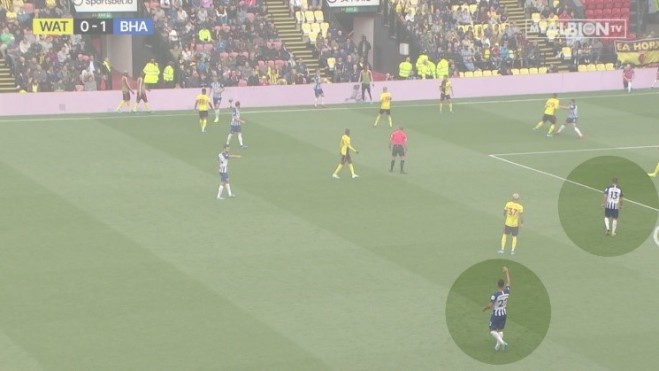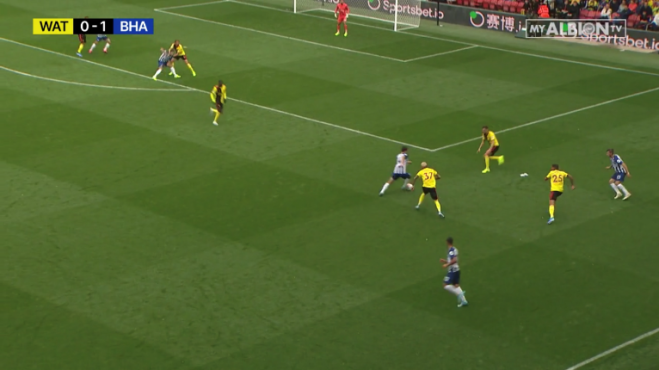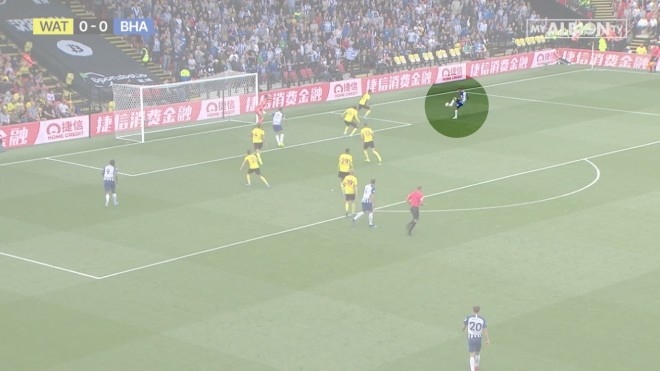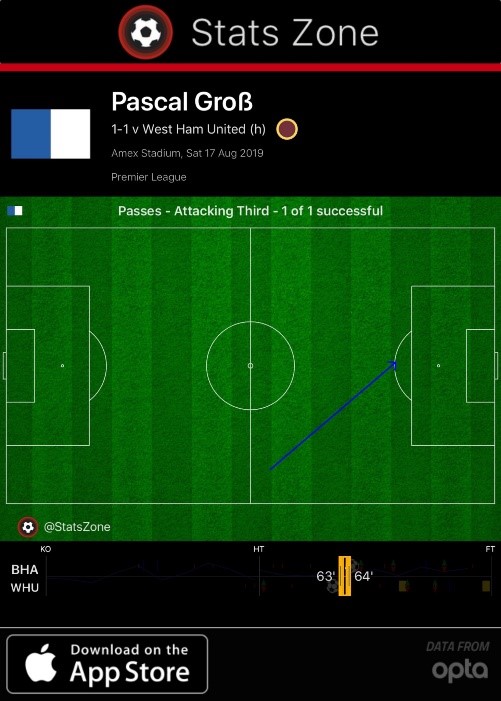Written by @AlbionAnalytics
Having set the Premier League alight with 15 goal involvements in his first season as a virtual unknown, Pascal Gross quickly became a key figure in the Albion side. Though just 2 games in, it appears the German has fit perfectly into Graham Potter’s new fluid 3-4-3 system, amid suggestions that he may be axed entirely from the side as he perhaps lacks the necessary requirements to operate in the new set-up – those suggestions have since stopped.
Versatility shouldn’t come as a surprise, though, given his role as a number 10 in Brighton’s first season, followed by playing as a deep-block RCM last season. It’s clear Gross has multiple dimensions to his playing style, both with and without the ball, though for this article I’m going to exclusively focus on the former. Graham Potter has managed to marry Gross’ extensive passing range and pinpoint accuracy with an attractive, fluid and attacking system. This piece will focus on how he has become the nucleus of this new-look side.
On paper, Pascal Gross doesn’t fit the mould as a right-winger. This isn’t an issue, because despite playing on the right-hand side of the forward three, he doesn’t operate as a typical winger. Perhaps a fair way to describe the German is through his native language, as a ‘raumdeuter’ – a ‘space investigator’. Gross loves the half-spaces and operates best as a link player, working as a primary outlet for the back line to play into – in particular his right-sided companion Martín Montoya.
Developing further on the Gross-Montoya relationship, Johan Cruyff – in his book ‘My Turn’ – talks of the importance of players needing to ‘complement’ each other, which is exactly what the two Europeans do. Potter has opted for Trossard or Locadia to the left of Murray, both of whom are ‘wrong-sided’ as they are right-footed and will therefore naturally drift inside into central areas as the angles there are more suited to them – Trossard highlighted this with his goal against West Ham. Whereas Gross is ‘right-sided’ and therefore would logically tend to stick closer to the right-hand channel. The two ‘average player positions’ (from SofaScore) highlight how Gross (13) typically operates in and around the half-space and right on the edge of that right-hand channel.
This compliments Montoya, who advances forward in the right-hand channel, perfectly, particularly at Watford. Gross helps to create an overload, often with Davy Pröpper – the right sided CM. A perfect example of this can be seen in the build-up to the second goal at Watford:

Gross drifts inside to a central area to provide a link option, which creates further space out in the right-hand channel. This allows Montoya to push further forward and act as an outlet to switch play – Albion attempted to switch play 8 times at Watford, completing 5, 4 of which were to Montoya and Gross’ right-hand side (StatsZone).
March’s looping back-post cross ended up being an indeliberate switch of play, as Montoya recovered the ball in the second phase following the headed clearance.
Roaming to connect play was a key part of Gross’ playing style in his breakthrough 17/18 season, which his heatmap from that season highlights (SofaScore). Although even then his preference to play in the right hand channel and half-space can be seen.

Here is the Montoya-Pröpper-Gross triangle; Albion exploiting a 3v3 in the right-hand channel, which Gross had dropped into, in behind Holebas, likely to provide a crossing action. Gross ends up acting as the ‘third man’ here, as Pröpper uses him by, well, not using him. Ultimately, Gross is used as a screen from Pröpper to drive wide with the ball to cross himself.

It is unsurprising to see Gross finding positions whereby he has an angle to cross, in the 17/18 season only Kevin De Bruyne played more crosses into the area – 248 to Gross’ 234 – and the German produced the most ‘good crosses’ (69) of any player in the league. Perhaps no surprise he assisted 8 goals in that season then. Despite having his minutes limited last season due to injury – playing just 1,876 minutes (less than 20 games total) – Gross was still in the top 10 for ‘good crosses’, though it should be noted that set-pieces do contribute significantly here.
Returning to the point of Gross in the half-spaces, his roles in Brighton’s first goals against Watford and West Ham deserve highlighting, but for different reasons.
The Gross-to-Murray combination which has proved so fruitful – 4 goals for this specific assist-goal combination in the 17/18 season alone (Transfermarkt) – was nearly added to at Watford, although Murray was robbed of a tap in by the outstretched leg of Doucouré. Not sure he was too bothered though, as the Watford man deflected it into the net. More importantly, Gross’ position in the final third is what I want to draw attention to. Despite this pass technically being ‘incompleted’, he completed 13 of the 18 passes in/into the final third he attempted – 72.2% conversion rate (StatsZone). He averaged 1.4 short key passes per 90 minutes last season (WhoScored) and his combined (short and long) 2.6 key passes per 90 minutes ranked 7th in the entire league last season – that’s level with Ryan Fraser for context.

Now to look at his chance creation from a long pass perspective against West Ham. Not to say that his passes in/into the final third weren’t good here, because they were; in fact, good is perhaps an understatement – 16 of 18 completed, which once again was the most on the pitch, showing even greater precision than at Watford with 88.8% competition (StatsZone).
One of these passes led to the goal – the Gross-Murray combination again would you believe? However, on this occasion Gross creates the chance with a long pass. As you can see on the passmap (StatsZone), he is again utilising that border between the half-space and right-hand channel to create chances. He created a total of 5 chances against West Ham (StatsZone) – the most on the pitch – and he only played 67 minutes!

With Gross leading the way for chance creation and final third passes, it is no surprise to see most of Brighton’s attacks taking place down the right-hand side. 48.8% of attacks against Watford and 44.3% of attacks against West Ham coming down the Pascal Gross side gives an average of 46.55% of attacks down the right. This exploitation of the right-hand side is a sensible one; Gross consistently creates chances and can do so because he frequently receives the ball and is involved in phases of play. This is reflected in pass patterns from the back line, and switches of play which were referenced earlier, that typically show movement of the ball from left to right. This is explored in more depth on my twitter page – @AlbionAnalytics.
Gross’ multidimensional threat will only be seen more throughout the season, as he continues to create chances and goals through short and long passes. Now this is without even highlighting his threat from set-pieces – Gross is also able to produce goals from corners, highlighted both in pre-season and the final game of last season by assisting Duffy against Valencia and Murray against Manchester City respectively from looping corners.
Hopefully this article provided an insight as to how one of the most underrated players in the league – given the statistical heights he reaches – has been moulded into a new set-up by Potter, into a player who is the same, but different.

